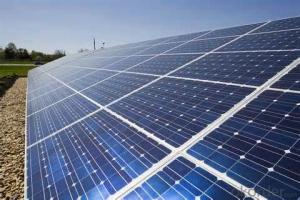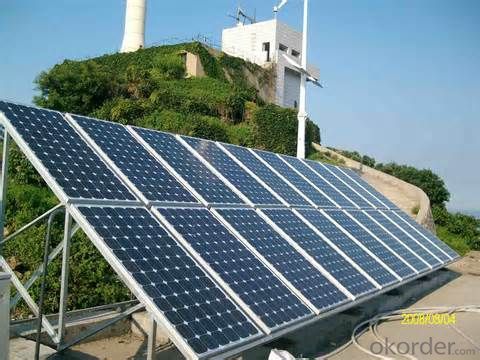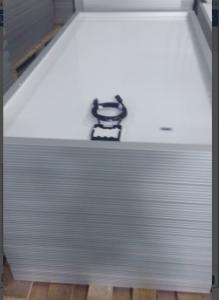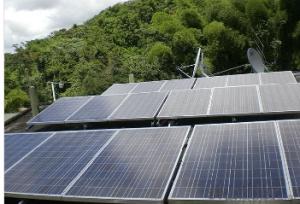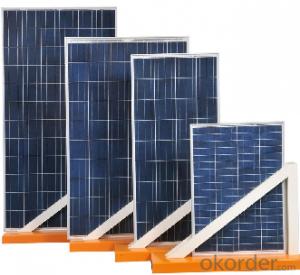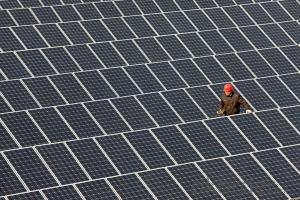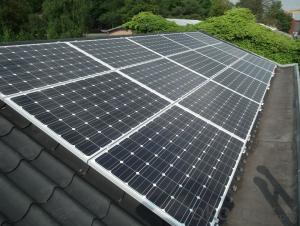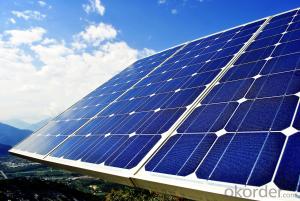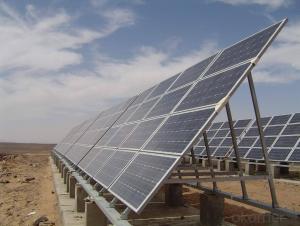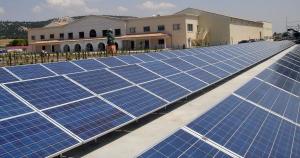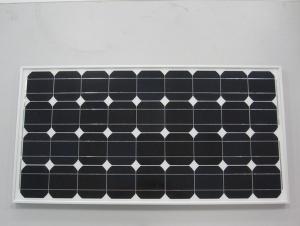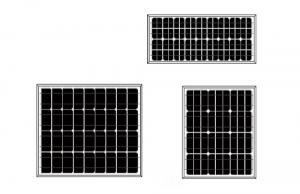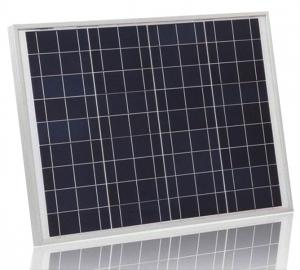Nova Solar Panels 50W Poly Solar Module with High Efficiency
- Loading Port:
- Tianjin
- Payment Terms:
- TT OR LC
- Min Order Qty:
- 1 watt
- Supply Capability:
- 100000 watt/month
OKorder Service Pledge
OKorder Financial Service
You Might Also Like
Specification
Product Description:
1.Structure of Solar Module Description
CNBM Solar's photovoltaic module is designed for designed for large electrical power requirement. It is the optimal choice for both on-grid and off-grid power systems. CNBM Solar offers high performance of power per square foot of solar array.
2.Main Features of the Solar Module
Solar Cell: High efficency crystalline solar cell. Even if under the weak light, the solar module can produce maximum power output.
Tempered glass: Anti-reflecting coating and high transmission rate glass increase the power output and mechanical strength of solar module.
EVA and TPT: Using high quality EVA and TPT to prevent destroying and water.
Strong aluminum frames to strengthen the load hold and to stand against high wind.
Junction box: Multi function junction box with water proof.
Long lifetime: ≥25 years; Less power decrease.
Good performance of preventing from atrocious weather such as wind and hails.
Resisting moisture and etching effectively, not effected by geology.
The certificate issued by international authority: UL, TUV, IEC, VDE, CE.
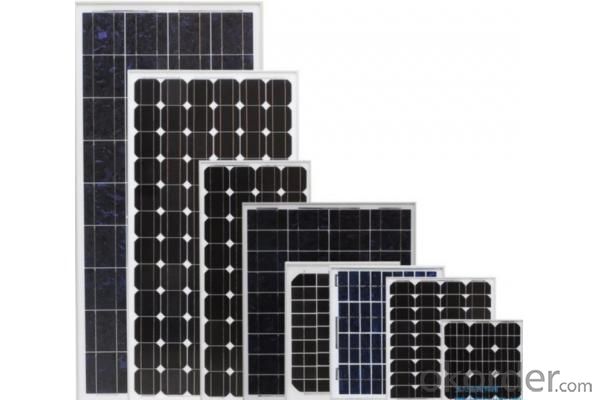
Solar panel working process
In addition to being the ultimate source of all life on earth, the sun is an infinitely renewable, completely pollution-free source of electricity. Instead of burning fossil fuels dug up from the ground in a big power plant – a very 19th century, industrial age approach, when you think about it – solar panels convert sunlight directly into electricity, with no harmful emissions.
The basic unit of a solar panel is a solar cell, which usually consists of one or two layers of silicon-based semiconductor wafers. When struck by the photons in sunlight, the solar cell generates an electrical charge due to the "photovoltaic effect" – which is a pretty good name, since it produces voltage from photons. The flow of these electrons moves in a steady electrical current from one side of the cell to the other.
Dozens of these PV cells are packaged together into solar modules, which in turn are packaged into solar panels that are mounted on a rooftop and arranged to maximize their hours of exposure to direct sunlight. Because the electricity generated by all those solar cells is direct current (DC), it is then sent to an inverter that transforms the power into the same alternating current (AC) used by the appliances in your home and the local utility electricity distribution grid. Increasingly, these inverters are getting "smart," providing data monitoring for solar installation performance and other grid integration services.
- Q: I am wondering how to store energy from a solar panel
- Now days there are been many equipement in the market such as solar panels is one such device which helps to generate solar energy.
- Q: . Does it really only cost $200 in contrast to $5000 or more?2. How much would it cost to build panels that would energize an entire average household? (washer, dryer, water heater, lights, fans, a/c)3. Is there a place to get the info on how to make them for free instead of paying E4E?4. Are the professional solar panels better? more efficient? 5. Will the electric company in So. Cal. really pay you?6. Do you have to be certified to do this professionally? or an electrician? If so what schools teach it?7. Would wind generators be of any use in So. Cal.? I mean don't you really need to get the fan spinning to get energy?8. Are there any extra unseen costs? (tools, energy converter, ect)9. How much is it to get an electrician to hook you to the grid?0. Is it better to hook to batteries or the grid? Pros, cons, why?
- I believe Earth4Energy to be a bald-faced scam, selling plans that will not do what is implied in the marketing, and imparting no information that is not publicly available on the internet, already. If you were to search for solar panel on torrent sites, most likely, some disgruntled customer has posted the material. It probably violates the E4E copyright, so I'm not suggesting that you get it in this manner. I'm going to skip many of your questions, given my already-stated opinion of Earth4Energy. Professionally-installed panels have a net cost of thousands of dollars in general. While they can save money (and Southern Cal is an ideal place for this), consider that it generally takes 0 years or more to get your money back. If you're on S Cal Edison, or SD Gas and Electric, you can go on net metering. They don't really pay you, they credit your electric bill. After a year, if you used more electricity than you generated, you pay them. If you generated more than you used, they reset the balance to zero and say thanks for your donation. You never really get a check, like in some other states. But you should have lower electric bills. You can put up panels for your own use without any certification. To put up panels professionally, you'll need a C-0 contractor's license from the state, or will need to be under the supervision of someone with such a license. But if it's the latter, you might just be the grunt that carries the panels off the truck and up the ladder, for minimum wage. I'd say better than 95% of residentail solar is connected to the grid, if the grid is available. It's a clear winner. Who wants to pay 50% more for their system, just to have batteries that need their water and acid checked all the time? Below is one of many unsatisfied customers from Earth4Energy. Be careful in your search, people selling these reports have bought up the keywords such as scam and ripoff to direct you back to sites selling the product.
- Q: If you want to instal solar panels...how often do you have to replace them?
- I have several friends that have large systems down in Mexico where there is no electric grid. They have had these systems for years. They say you probably should plan on at least 0 years with decent output. The capacity does taper off with time so maybe half power in 5 years might be a good assumption. Here in Arizona our payback (Break even) point is about 8-9 years. Our state has subsidies along with fed, and utility company. A 3000 watt system will cost about $0,000 installed. That is about half off regular price.
- Q: How much energy can a solar panel produce?
- The amount of energy a solar panel can produce depends on various factors such as its size, efficiency, location, weather conditions, and orientation. On average, a standard residential solar panel can produce anywhere from 250 to 400 watts of power. However, with advancements in technology, larger solar panels or those used in commercial installations can generate several kilowatts or even megawatts of electricity.
- Q: first of all, to be honest i have totally no idea on how a solar panel works.my task is to design something like a solar powered street lamp which store sun energy during day time and convert it into electrical energy then light energy so that the lamp can work during night time.any ideas on how to design the solar panel? which can store enough or more enegry in case there is no sunlight another day. and low cost as well :D
- solar panels are designed to charge 2v batteries, now depending on the power you need you can determine what kind to use there are many power ratings for the modules, for example if you want to charge two 2v batteries you can connect them in parallel, if you want to reduce the charging time you can use more than one module in parallel to increase the power.
- Q: Can solar panels be damaged by hail or other elements?
- Yes, solar panels can be damaged by hail or other elements. Hailstones can cause cracks or dents on the surface of the panels, reducing their efficiency. Additionally, other elements like strong winds, debris, or extreme weather conditions can also potentially damage solar panels. However, modern solar panels are designed to withstand various weather conditions and are often tested for durability.
- Q: How do solar panels affect the environment?
- Solar panels have a positive impact on the environment as they produce clean and renewable energy, reducing the need for fossil fuels. They help decrease greenhouse gas emissions, air pollution, and water usage associated with traditional energy sources. However, the production and disposal of solar panels can have some environmental impact, including the use of certain materials and energy during manufacturing. Overall, their benefits outweigh the potential drawbacks.
- Q: Can solar panels be installed on a museum or cultural institution?
- Yes, solar panels can be installed on a museum or cultural institution. Installing solar panels can help these institutions reduce their energy costs and carbon footprint, while also showcasing their commitment to sustainability and environmental stewardship. Additionally, solar panels can be installed on rooftops or in nearby open spaces, minimizing any aesthetic impact on the museum's architecture or surrounding areas.
- Q: I want to get definate instructions on how to make the components and convert my home to solar energy. I know I could hire some one to do this, but frankly I do not have the funds at my disposal to do it. I thought if I could find detailed instuctions I could slowly do it myself (with my husband's help). I have looked into loans for this purpose to no avail. Finding the information on the net could take forever! If anyone knows a site that would give me the information or even a hint on how to start? Any help will be appreciated, but if you have any good links to good information please share them with me..Thanks
- I doubt that you are going to want to learn how to dope your own silicon wafers, add contacts and laminate them into PV panels.? I also doubt that you're going to even want the various chemicals to make e.g. cadmium-based cells anywhere near your house (cadmium is a very toxic metal).? In other words, making your own solar panels is not an at-home project. You can buy solar panels based on cells of several different types.? A link to a Pricewatch-like website for current prices on solar panels is below.? Mounting panels to roofs or pole mounts, running conduit and wires, and installing battery banks and inverters are within the capabilities of skilled laypeople. More data at the links. Edit:? I am reporting all of Agua-Luna's cut-and-paste pieces as spam.? I encourage others to do likewise.
- Q: Can solar panels be installed on a school or educational institution?
- Yes, solar panels can be installed on a school or educational institution. In fact, many educational institutions are now adopting solar energy as a sustainable and cost-effective solution to meet their electricity needs. Installing solar panels not only reduces carbon footprint and saves on energy costs but also provides an opportunity for students to learn about renewable energy and sustainable practices.
Send your message to us
Nova Solar Panels 50W Poly Solar Module with High Efficiency
- Loading Port:
- Tianjin
- Payment Terms:
- TT OR LC
- Min Order Qty:
- 1 watt
- Supply Capability:
- 100000 watt/month
OKorder Service Pledge
OKorder Financial Service
Similar products
Hot products
Hot Searches
Related keywords
